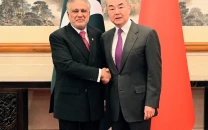Earthquakes won’t destroy the city, faulty constructions will, say geology experts
Constructions on seismic fault lines located within the city can cause massive destruction

Constructions on seismic fault lines located within the city can cause massive destruction. PHOTO: AFP
The people of Karachi have more to fear from constructions made over seismic fault lines than from an actual earthquake.
According to geology experts, the city is not that vulnerable to earthquakes. “However, substandard constructions over the fault lines in the city can be disastrous,” said Dr Adnan Khan, an assistant professor at the University of Karachi’s geology department.
11 earthquake facts that will shake you to the core

As the northern areas of the country reel from the destruction caused by the 7.5 magnitude earthquake last week, Khan assured that Karachi does not face any imminent threat from one. However, seismic activity in close vicinity can reach the city and destroy it. Since the city is located on the Indian tectonic plate that are, according to Khan, on passive margin, it is relatively safer.
The chances of a tsunami hitting Karachi are also relatively less, said Yasmeen Raza, an assistant director at the Geological Survey of Pakistan. She said that the Makran subduction zone can be affected the most in case of an earthquake, which could generate a tsunami; however, she said that was a passive margin but could get active anytime.
Higher than Everest
Khan explained how vulnerable the city is to the movement of continental plates. The Indian and Arabian plates are moving north at a speed of five centimetres per year, which is causing the western portion of Himalayan range to lift up at a higher rate than the eastern range, which includes Mount Everest. This means that, in the years to come, there are chances of the Western Himalayas crossing Mount Everest and becoming the tallest peak.
20 pictures that show the aftermath of Pakistan’s 7.5-magnitude earthquake
The uplift and movement of these plates, and the energy accumulated and released through them is what causes destruction. But, Khan assured, Karachi is quite far away from the effects of such energy.
Fault in our construction
Fault lines are those parts of the land whose surface is not levelled. For example, a hill range that has huge gaps is a sign of a fault line. “The rock patterns and the layers of land reveals whether or not the area is on a fault line,” said Khan.
The professor identified Hawke’s Bay, Manghopir and parts of Gadap Town as areas where major fault lines exist, while the minor ones exist in Gulistan-e-Jauhar, PECHS and Soneri. This means that any vibrations caused by an earthquake will be amplified in these areas and, hence, cause more destruction. “The construction of a 12-storey building on a fault line is definitely the fault of the building control authority,” Khan pointed out.
Here’s what you should do during an earthquake

When the vibration of any building and the earth coincide, it enhances the energy. Therefore, the construction should be carried out keeping in mind the safe number of floors that can be built on a fault line and in anticipation of any earthquakes that can take place. Unfortunately, according to Khan, the master plan in Karachi was designed demographically not technically.
SBCA lists hazardous building
For its part, the building control authority issued a list of over 300 hazardous structures in the city. Most of these are located in Old City areas.
The SBCA’s job is merely to identify these dangerous buildings, claimed the authority’s spokesperson Farhan Qaiser, adding that the deputy commissioners and the law enforcement agencies have to get them vacated.
Desperation grows as Pakistan quake victims wait for aid
“We have been serving notices for years,” he said. Qaiser admitted that it is difficult to make the residents leave unless they are provided an alternative residence.
He defended his department against ‘uncontrollable’ construction taking place in the city. Certified engineers of the SBCA have given no-objection certificates after monitoring the elasticity of the structures, he said, adding that the intensity of earthquakes and the destruction they cause cannot be forecast.
Meanwhile, SBCA’s acting director-general Mumtaz Hyder drafted, last week, a course of action to demolish these unstable buildings. Earthquakes can cause more damage in urban areas with large buildings and thick population as compared to rural areas, he said.
Google launches tool to locate earthquake victims
The authority had issued notices to the occupants of these hazardous buildings, along with letters to the relevant departments to discontinue the supply of utilities to them, he said. “Separate line of action is being worked out for dangerous buildings that are part of the national heritage,” he added.
In the first phase of this action plan, people will be warned about the dangers of living in these buildings through loudspeakers, banners and advertisements. Camps will be set up across the city for a public awareness campaign, he added.
Published in The Express Tribune, November 2nd, 2015.



















COMMENTS
Comments are moderated and generally will be posted if they are on-topic and not abusive.
For more information, please see our Comments FAQ